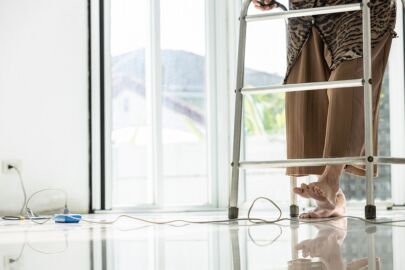10 ways to make your home more dementia friendly
If you or a loved one have dementia, making some changes to the immediate environment can boost safety and make the property more comfortable.
As dementia progresses, familiar surroundings become more important, and safety at home is also a greater priority if someone with dementia is to get around confidently.
We’ve put together some helpful ways to make your home more dementia friendly, which should support you or your loved one in living independently for longer.
1. Cut down on clutter
Clutter makes it more difficult to see items that someone uses in the day to day. When everyday things are difficult to see, the person living with dementia may become confused and rummage to try and find them.
Clearing away clutter ensures that these frequently used items are easy to find, which reduces the opportunity for confusion and any associated stress.

2. Remove trip hazards
Falls are one of the most common reasons people with dementia are admitted to hospital. By removing trip hazards, the risk of falling at home is significantly reduced.
Hazards can be anything from clutter left on the floor to mats, rugs and trailing wires. It’s a good idea to remove these items and keep the floor as clear as possible.
3. Label drawers and cupboards
Over time, someone with dementia may start forgetting where certain items can be found in the house – particularly in the kitchen, where there are usually lots of drawers and cupboards.
To make life a bit easier and help the person find what they need, when they need it, try labelling cupboards and drawers in clear text that’s large enough to read. The bedroom is another area where labelling drawers can be helpful.
4. Keep patterns to a minimum
Patterns can be very visually confusing to someone living with dementia, and too many patterns may be overstimulating, which can cause agitation.
Contrasting colours, however, have the opposite effect in helping people see things more clearly. If the decor at home is particularly pattern-heavy, it could be worthwhile redecorating.
5. Place photographs around the house
Family photos and important keepsakes can evoke pleasant memories for someone living with dementia. Seeing items from the past may encourage the person to reminisce, which can make them feel more positive.
Place sentimental items strategically around the house so that when the person goes about their daily routine, they’re likely to see these happy mementos.

6. Keep chemicals and medicines secure
Keeping potentially dangerous chemicals and medicines out of sight can help reduce risks at home for someone living with dementia.
Cleaning products, medication and alcohol are best stored out of sight and in some cases, locked away securely.
7. Choose outfits in advance
Having too much choice can be overwhelming for someone with dementia and facing a wardrobe full of clothes or packed drawers can make the decision-making process difficult.
Bring out a few options when helping someone with dementia choose an outfit and lay out or hang up the clothes somewhere accessible in the order they will be put on, ready for the next day.
8. Switch out mixer taps
Mixer taps that run both hot and cold water pose a confusing prospect, along with a risk of scalding.
Consider switching out modern mixer taps in favour of traditional hot and cold taps that are labelled, which are easier to use and less dangerous for individuals with dementia.
9. Install simple safety mechanisms
There are lots of small, simple ways to enhance safety in your home if you’re living with dementia, such as installing special plugs in the bath that let water out when the bath becomes too full or change colour when the water is too hot.
In the kitchen, you can fit shut-off mechanisms on older cookers (new ones already have these installed) so even if you leave it on, the cooker will automatically switch itself off.
10. Mark steps and stairs
Dementia can make judging the depth of stairs and steps more difficult. To avoid the risk of trips and falls, mark the edge of each step or stair to help the person with dementia get around more confidently.
Outdoors, you can use coloured paint to mark the edge of steps; inside, you can fit special edging called nosing or use colourful tape.
For more information about making your home dementia-friendly, Ambiance Advice can help – just call us on 0161 537 0983 to find out more.


